Understanding the significance of safety helmets and their varied types is crucial for anyone working in hazardous environments or participating in high-risk activities. In this blog post, we delve deep into the world of safety helmets, also known as hard hats, discussing their importance and their specific roles in different settings.
We’ll explore a variety of safety helmet types, each with its unique designs and uses – from the common industrial hard hats used in construction and manufacturing sectors to specialized helmets for firefighters, miners, and even outdoor enthusiasts. Let’s embark on this journey to comprehend how these vital personal protective equipment contribute to our safety and well-being.
What’s Safety Helmet?
A safety helmet is a form of protective headgear worn to shield the head from injuries such as impact from falling objects, collisions, or protection against certain environmental conditions. It is a type of personal protective equipment designed to safeguard the wearer’s head, one of the body’s most vulnerable parts to injuries. Safety helmets are typically made from hard, impact-resistant materials like plastic or fibreglass and often have a padded interior for comfort and additional protection.
Safety helmets are used in various industries and activities, including construction, mining, road safety, sports, and manufacturing. They might also be called hard hats, helmets, or protective headgear in different contexts.
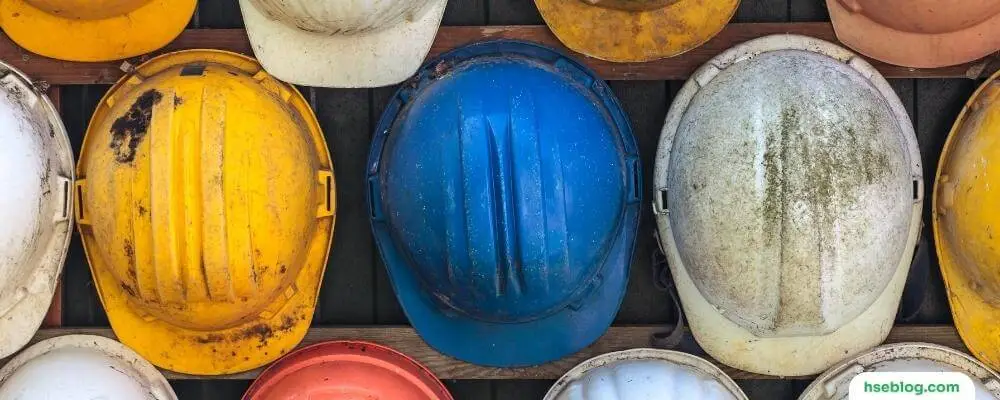
Importance Of Safety Helmets
The importance of safety helmets in various environments and activities cannot be overstated. These helmets are crucial in protecting individuals from head injuries, which can be life-threatening or lead to long-term disabilities. Below are several reasons why safety helmets are vital:
- Protection from Falling Objects: Protection from Falling Objects: There’s a constant risk of objects falling from heights in industries like construction and mining. A safety helmet can significantly reduce the impact and protect the worker’s head. For full-body protection, combining a safety helmet with protective footwear equipped with metatarsal guards can safeguard the feet from falling debris and heavy objects.
- Impact Protection in Accidents: During road accidents, particularly involving motorcycles and bicycles, a helmet can protect the head from severe injuries by absorbing the shock and reducing the impact force.
- Electrical Safety: Some safety helmets are specially designed to protect the head from electrical shocks, which is essential for electricians and people working in high-voltage environments.
- Protection from Cuts and Scrapes: Safety helmets can prevent cuts and scrapes to the head, which can be caused by contact with sharp or rough surfaces.
- Temperature and Weather Protection: Helmets can offer protection from extreme weather conditions such as rain, sun, and cold, which is essential for outdoor workers.
- Protecting Against Hair Entanglement: In manufacturing environments with machinery, helmets can prevent long hair from getting entangled in the machines.
- Improved Visibility: Many safety helmets have reflective materials that improve the wearer’s visibility in low-light conditions, reducing the risk of accidents.
- Reducing Legal Liability and Compliance with Regulations: Wearing safety helmets is often mandated by laws and regulations. Compliance reduces the legal liability for companies in case of accidents and is necessary to avoid fines and penalties.
- Encouraging a Safety Culture: Using safety helmets helps foster a safety culture within an organization. When employees see that their safety is taken seriously, they are more likely to adhere to other safety protocols.
- Protection from Chemical Spills and Burns: In chemical plants and laboratories, safety helmets can protect the head from harmful chemicals and burns.
By safeguarding against these risks, safety helmets protect the individual. They can have broader implications, such as reducing healthcare costs, minimizing loss of manpower due to injuries, and maintaining productivity and morale within the workplace. Choosing the appropriate type of safety helmet for the specific risks and environments involved is essential.
Types Of Safety Helmets and Their Uses
Safety helmets, also known, are essential pieces of personal protective equipment used in various industries and professions to protect the head from injuries. Here are 10 types of safety helmets and their typical uses:

1. Standard Industrial Helmets
Standard Industrial Helmets, commonly known as hard hats, are designed to protect the wearer’s head from injuries caused by falling objects, debris, or accidental head contact with stationary objects on construction sites, manufacturing plants, or warehouses. They typically have a rigid outer shell of materials like high-density polyethylene (HDPE) or polycarbonate, capable of withstanding impacts and penetration. Inside the shell, a suspension system acts as a shock absorber, spreading the force of an impact over a larger area of the head. This system also keeps a clearance between the shell and the user’s head, allowing for ventilation.
Some industrial helmets also come with additional features, such as slots for mounting face shields, earmuffs, or headlamps, and may have a brim for shade against the sun. They are available in various colors, which can designate different roles on a worksite. Understanding hard hat color coding helps workers quickly identify team roles and enhance site safety. To ensure adequate protection, these helmets must comply with standards like ANSI Z89.1 in the US or EN 397 in Europe.
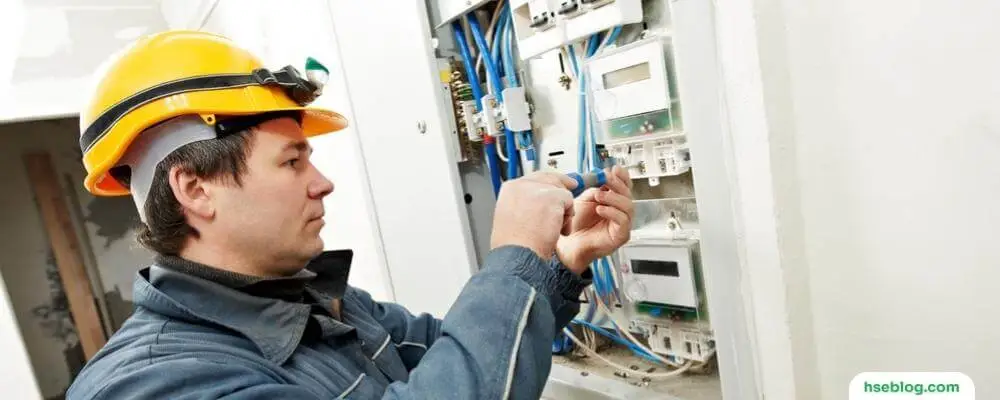
2. Electrical Safety Helmets
Electrical Safety Helmets are designed to protect electricians and workers exposed to electrical hazards, such as working with high-voltage lines or equipment. These helmets are made from non-conductive materials, such as reinforced fibreglass or high-density polyethylene, that do not conduct electricity. This is crucial in minimizing the risk of electrical shocks or arcs, which can be fatal. Similar to standard industrial helmets, they also have a suspension system inside the shell, providing impact protection.
Additionally, Electrical Safety Helmets often have an extended brim or arc shield that helps to prevent electrical arcs from reaching the face and neck. These helmets must comply with stringent standards and regulations, such as ANSI Z89.1 Class E in the US, which certifies that the helmet can withstand up to 20,000 volts of electrical current. It’s important for users to regularly inspect and replace Electrical Safety Helmets as per the manufacturer’s recommendations because any degradation of the materials can reduce their protective capabilities.
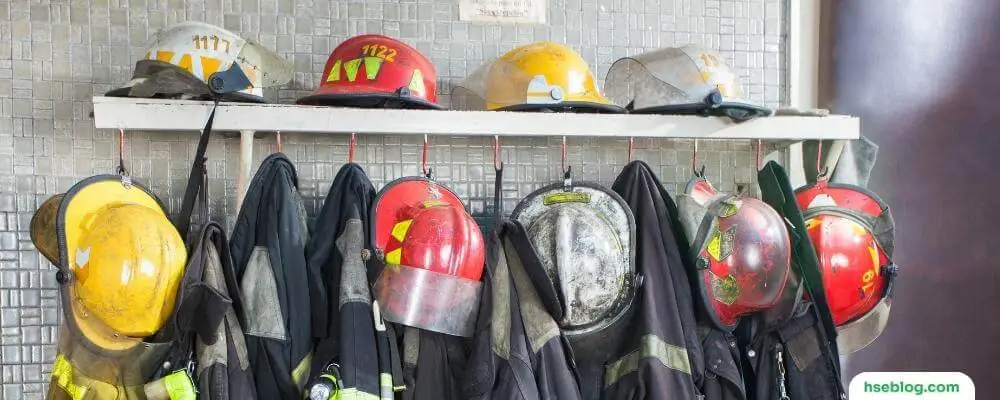
3. Firefighter Helmets
Firefighter helmets are critical personal protective equipment designed to shield firefighters from the numerous hazards they face, such as extreme temperatures, falling debris, and exposure to flames and hot gases. The helmets are typically constructed from heat-resistant materials like fibreglass, thermoplastics, or Kevlar. They usually feature a rigid shell that provides impact protection and an inner lining that offers thermal protection.
Many firefighter’s helmets also have integrated face shields or flip-down visors to protect the eyes and face from heat and flying debris and neck protectors to shield against falling hot embers. These helmets are often equipped with mounts for accessories such as flashlights or communication devices. In many countries, firefighter helmets must meet strict standards, such as those set by the National Fire Protection Association (NFPA) in the United States, which dictate performance requirements for thermal resistance, impact protection, visibility, and other critical factors.
Reflective striping is also common on firefighters’ helmets to improve visibility in smoke-filled or low-light environments. Regular maintenance and inspection are essential for ensuring the helmet provides the necessary protection.
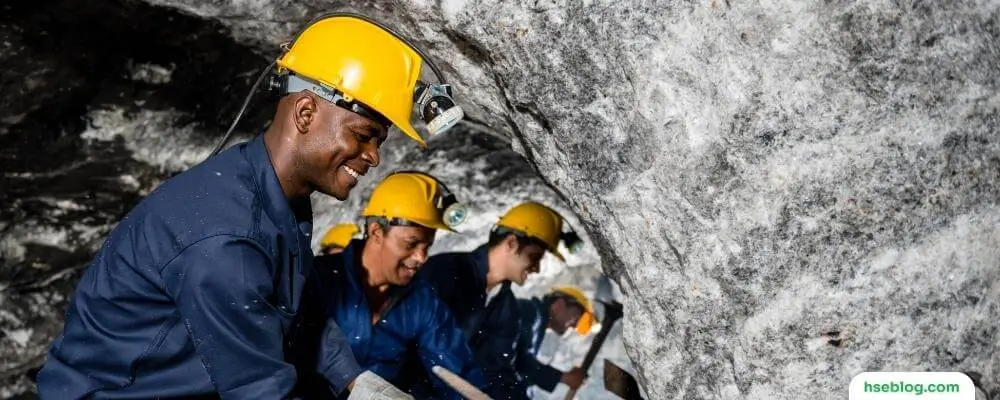
4. Mining Helmets
Mining helmets, often called miners’ helmets or hard hats, are an essential piece of personal protective equipment for individuals working in the mining industry. These helmets are usually made from durable materials like polycarbonate or fibreglass. They are designed to protect the head from falling rocks, debris, and other hazards typical in underground mining environments.
One of the distinct features of mining helmets is the integration of a headlamp or light source, which is vital in the dimly lit conditions of underground mines. The lamp helps miners to see clearly and work safely. Many mining helmets also have mounts for accessories like ear protectors or face shields. Ventilation is another critical aspect; some mining helmets include vents to help reduce heat buildup and improve comfort for the wearer.
Additionally, the helmets may have reflective materials for enhanced visibility in low-light conditions. Safety standards, such as those outlined by the Mine Safety and Health Administration (MSHA) in the United States, regulate the design and performance of mining helmets to ensure they provide adequate protection against the specific risks faced in mining environments.
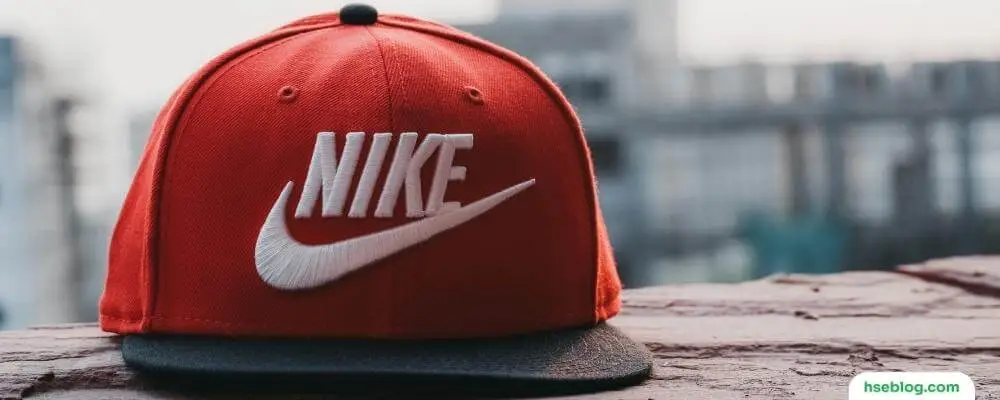
5. Bump Caps
Bump caps are a type of protective headgear designed to provide lightweight protection against minor scalp bumps, scrapes, and lacerations. They are not intended for protection against falling or flying objects, or high-impact collisions, which would require a more robust safety helmet. Bump caps often resemble baseball caps and are made of a hard plastic shell sewn or inserted into the cap’s lining. This design is usually more comfortable and stylish than traditional hard hats, making them more appealing for environments with relatively low risk, but some protection is still necessary.
Commonly, bump caps are used in areas like warehouses, food processing plants, maintenance departments, and some manufacturing settings where there is no heavy machinery or high-altitude work. It is important to recognize the limitations of bump caps and to ensure that they are only used in situations for which they are designed, as they do not offer the same level of protection as standard industrial safety helmets.
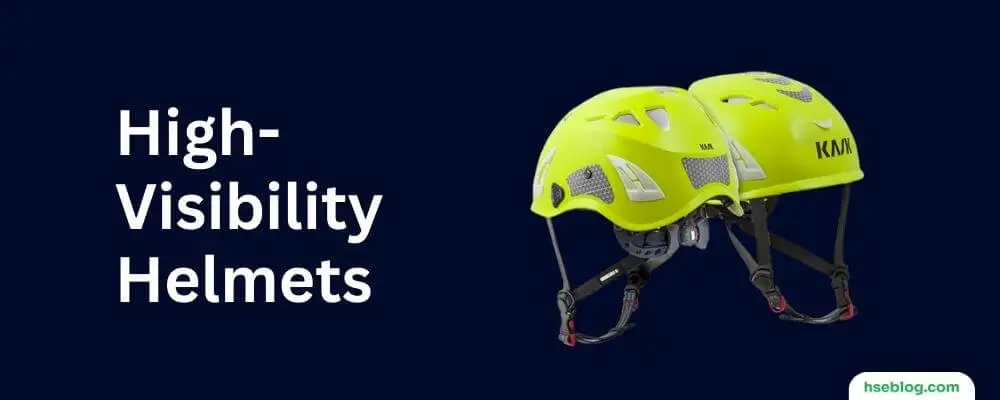
6. High-Visibility Helmets
High-Visibility Helmets are designed to ensure that the wearer is easily seen in low-light conditions or environments where visibility is critical. This is particularly important in road construction, traffic control, nighttime operations, and any situation where the worker needs to be clearly visible to avoid accidents. The helmets are generally made in bright, neon colours such as fluorescent yellow, orange, or lime green to ensure they stand out in any background. They often also have reflective strips or tapes attached, which can reflect light from vehicle headlights or other sources, further increasing the wearer’s visibility.
Some high-visibility helmets might also incorporate built-in LED lights for added visibility. It is crucial that these helmets not only serve the purpose of being visible but also protect the wearer’s head from impacts and falling objects. Thus, they are usually constructed similarly to standard industrial helmets but with additional features for visibility. Ensuring that personnel is easily visible can significantly reduce the risk of accidents, especially in hectic or poorly lit environments.
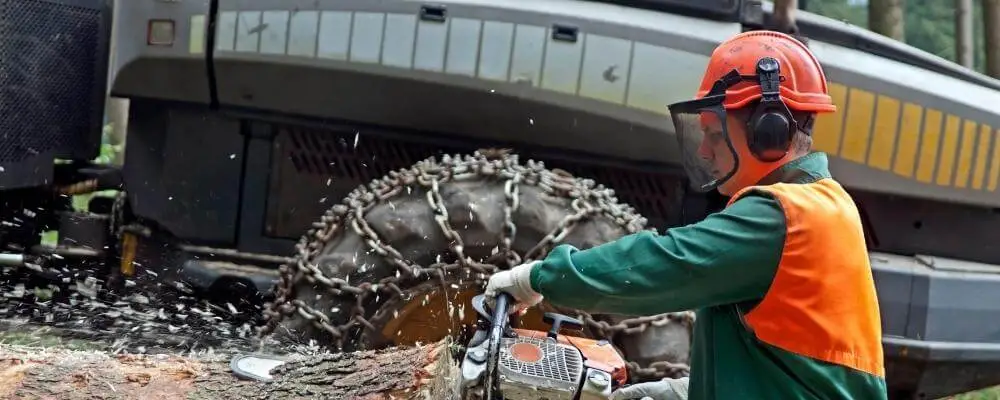
7. Forestry Helmets
Forestry Helmets are specifically designed for the safety of workers engaged in the forestry industry, such as lumberjacks, tree surgeons, and arborists. These helmets provide comprehensive protection, as working with trees involves several risks, including falling branches, flying debris, chainsaw accidents, and high noise levels. A standard forestry helmet typically comprises a hard shell for head protection, a mesh face shield to protect the face from flying debris, and ear muffs to shield the ears from the loud noise of chainsaws and other machinery.
The mesh face shield is particularly important because it protects the face while maintaining visibility, which is crucial when operating a chainsaw or moving around in a dense forest. The helmets are usually lightweight and ventilated to ensure comfort during long work hours. Some forestry helmets might also come with a neck cape to protect the back of the neck from debris and a short brim to shield the eyes from sunlight. Choosing a forestry helmet that meets industry standards and regulations is critical for ensuring the highest level of protection and safety during tree work.
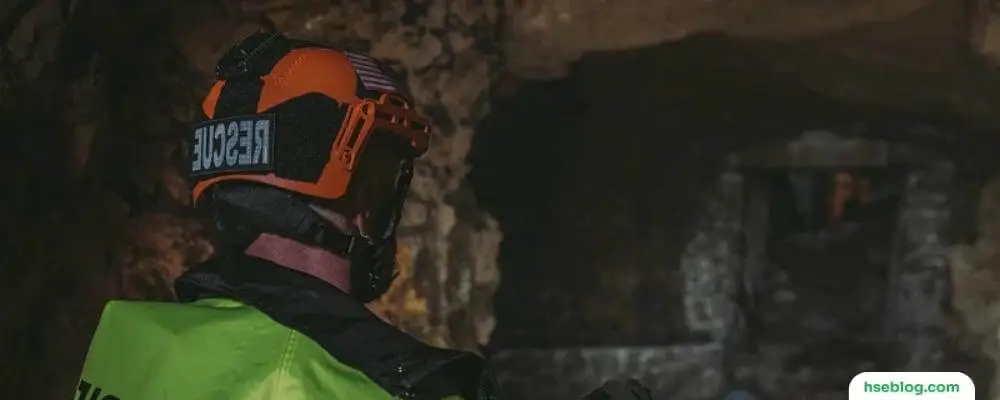
8. Rescue Helmets
Rescue Helmets are specialized safety helmets used by search and rescue teams during operations that involve locating and assisting people in distress or imminent danger, often in difficult or hazardous environments. These helmets are built to provide high-impact protection to the wearer’s head, as rescue operations often occur in areas with falling debris, unstable structures, or rough terrains.
In addition to impact protection, rescue helmets often come equipped with integrated communication systems, allowing team members to maintain contact with each other and command centres. This is critical for coordinating efforts and ensuring the rescue team’s safety and those they are helping. Another common feature is the inclusion of mountable lights, essential for operations in low-light conditions, such as during nighttime or confined spaces. Face shields or visors are often attached to protect the face from flying debris or hazardous materials.
Furthermore, rescue helmets may have additional features such as a neck protector, reflective markings for visibility, and attachments for carrying small tools or equipment. Due to the diverse nature of rescue operations, the helmets must meet specific standards and be adapted to the mission’s conditions.
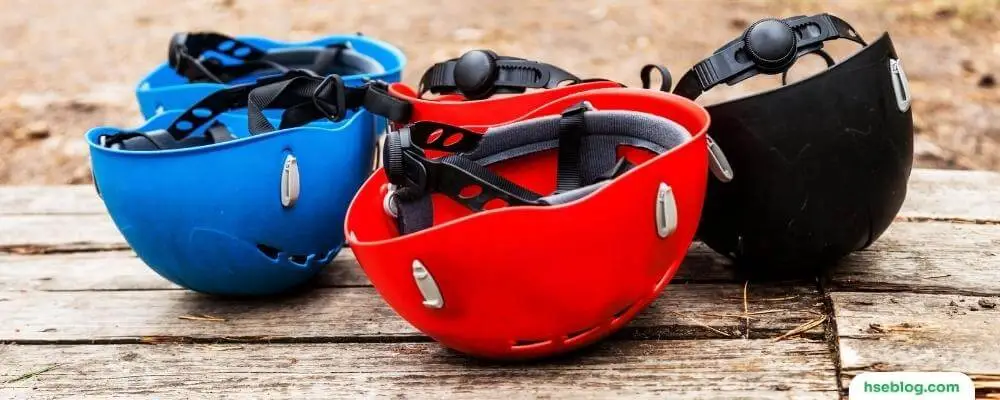
9. Climbing and Mountaineering Helmets
Climbing and Mountaineering Helmets are specifically designed to provide head protection for individuals engaged in rock climbing, mountaineering, and other related activities. These helmets are crucial for reducing the risk of head injuries from falling rocks, debris, or equipment and from impact against the rock face during a fall. Climbing and mountaineering helmets are generally lightweight and comfortable, worn for extended periods during ascents and technical climbs.
The materials used for these helmets typically combine durability and impact resistance with low weight. They usually feature a hard outer shell that disperses the energy of an impact and an inner foam lining that absorbs this energy to minimize forces on the head. Moreover, these helmets often have good ventilation systems to keep the wearer cool and reduce sweating, which is particularly important during strenuous physical activity. Many climbing helmets also include attachment points for headlamps, essential for climbing in low-light conditions or during night-time ascents.
Finally, they are designed to provide a secure fit even during dynamic movements and often have adjustable straps for customizing the fit. Climbers and mountaineers must choose a helmet that meets recognized safety standards and is suited to the specific climbing activities they are engaged in.
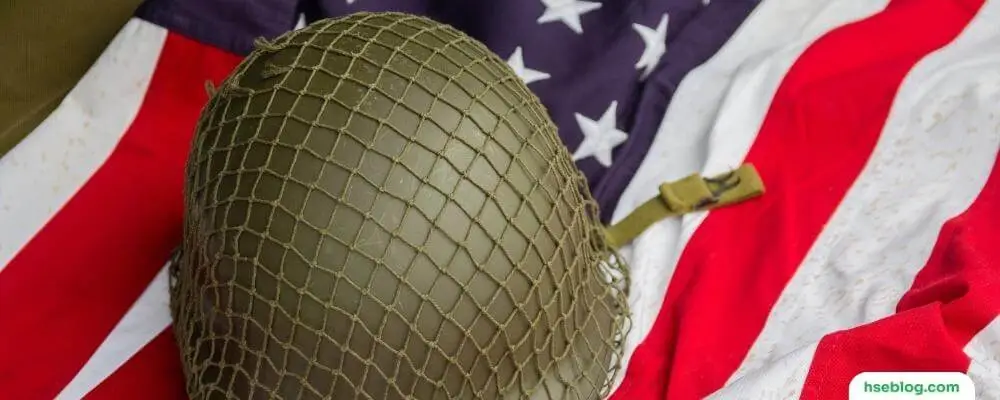
10. Military Helmets
Military helmets, often called combat or ballistic helmets, are specifically designed to protect soldiers and military personnel from various threats, including bullets, shrapnel, and blasts. They are essential to a soldier’s personal protective equipment and have evolved over the years to incorporate advanced materials and technologies. Modern military helmets typically have a layered construction, often including a hard outer shell made from Kevlar or other ballistic fibres and an inner layer of padding for shock absorption and comfort.
The shape of military helmets is also vital in providing protection. The designs are meant to deflect or absorb the energy of incoming projectiles and minimize the risk of neck injuries when a soldier is exposed to a blast wave. Helmets often include mounting systems for attaching additional equipment such as night vision goggles, communication headsets, and cameras. This integration is essential in modern warfare as soldiers must be equipped with various communication, vision, and situational awareness tools.
Conclusion
In conclusion, safety helmets are an indispensable element of personal protective equipment that safeguards individuals across numerous industries and activities. From industrial hard hats, electrical safety helmets, and firefighter’s helmets to those specialized for mining, high-visibility, forestry, rescue, climbing, and military purposes – each design is tailored to combat specific hazards. Understanding the functionalities and applications of these diverse safety helmets is fundamental to ensuring the right type of protection, thus minimizing the risks and fostering a safer environment for all.

